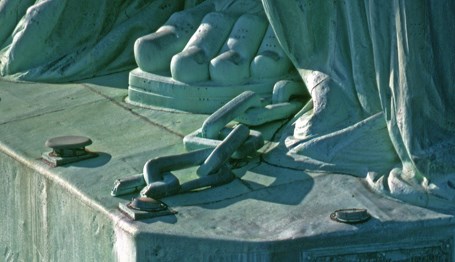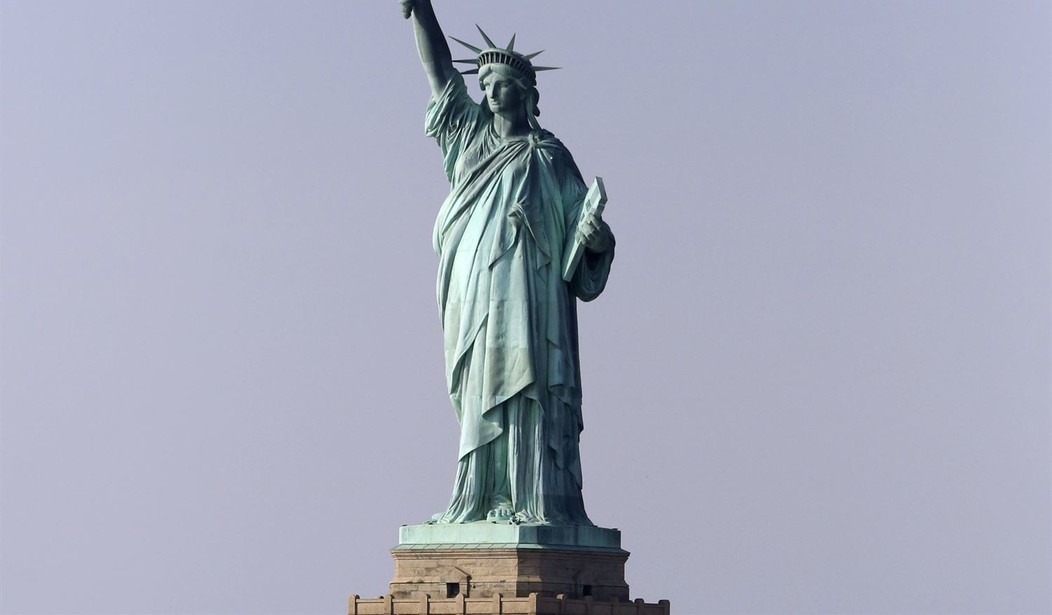Nearly two decades after the 1886 erection and public dedication of the Statue of Liberty in New York Harbor, a poem was inscribed upon a bronze plaque and placed on her pedestal. And ever since then, the Left has erroneously used Lazarus’s poem to justify open-door immigration policies.
The New Colossus
Not like the brazen giant of Greek fame,
With conquering limbs astride from land to land;
Here at our sea-washed, sunset gates shall stand
A mighty woman with a torch, whose flame
Is the imprisoned lightning, and her name
Mother of Exiles. From her beacon-hand
Glows world-wide welcome; her mild eyes command
The air-bridged harbor that twin cities frame.
“Keep, ancient lands, your storied pomp!” cries she
With silent lips. “Give me your tired, your poor,
Your huddled masses yearning to breathe free,
The wretched refuse of your teeming shore.
Send these, the homeless, tempest-tost to me,
I lift my lamp beside the golden door!”— Emma Lazarus, November 2, 1883
Initially, “the Statue of Liberty was a symbol of democratic government and Enlightenment ideals as well as a celebration of the Union’s victory in the American Civil War and the abolition of slavery.” In other words, it had nothing whatsoever to do with immigration. The French abolitionist who first proposed the statue, Edouard de Laboulaye, was an expert on the U.S. Constitution and a political thinker of the day. Although Laboulaye was French, he was an honorary member of the Union League Club of Philadelphia, which was “dedicated to the new Republican Party, the Union’s cause in the Civil War, and the abolition of slavery.” For years, Laboulaye called for abolishing slavery worldwide and later he actively raised money for newly freed slaves in the United States.
Recommended: ‘Do You Want to Be Free?’ The Promise of America on Independence Day
Even though the Statue of Liberty originally stood for “democracy but also symbolized American independence and the end of all types of servitude and oppression,” many black Americans continued to feel the sting of discrimination and racism. Even Lady Liberty’s broken chains symbolizing the end of slavery were seen by some as ironic given that blacks were not fully welcomed into American society in some parts of the nation.

Photo: National Park Service, Statue of Liberty NM
In truth, black Americans saw Lady Liberty not as the end of their fight for freedom, but as a beginning. “The fight for equality, liberty, and justice for all at [that] point in time had not been achieved, but rather disregarded after the Statue’s completion and dedication.” It wasn’t until a fundraiser was held to raise funds for a pedestal at the base of the statue and Lazarus’s poem was chosen that the Left began to twist her meaning. The poem distorted Lady Liberty not as a monument to the abolition of slavery and celebration of freedom, but as a symbol allowing for the unlimited and unregulated entrance of any and all migrants from around the world.
Even Lady Liberty’s torch became not a symbol of enlightenment as Laboulaye had intended when naming her “Liberty Enlightening the World,” but a magnetic-like beacon calling all the world’s “poor” and “huddled masses” to her. Her torch was meant to symbolize the freedom of America and be a symbol of hope for the world; however, the Left uses her freedom to justify open borders and lawless immigration. And so it’s been ever since, but the difference is now you know the truth.
Enjoy LIVE views from Lady Liberty’s torch. Happy Independence Day.










Join the conversation as a VIP Member